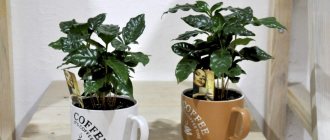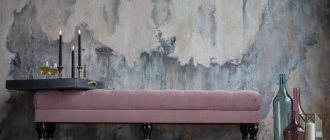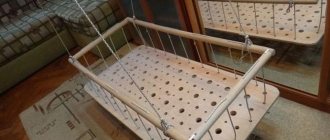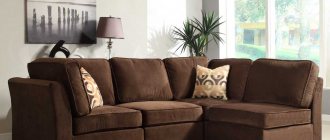Indoor flowers as part of the interior
When designing a living space, it is worth noting that the design should not only please the eye, but also provide comfort. The arrangement of flowers in the interior of the apartment should be organized so that the room is not cluttered, but its advantages are emphasized. An interior with flowers in an apartment looks more comfortable and has undeniable advantages:
- an abundance of greenery relieves eye fatigue and helps you relax after a hard day at work;
- fresh flowers regulate humidity and purify the air;
- plants can optically change the proportions of a room.
It doesn’t matter whether you use fresh flowers in the interior of your home or use artificial analogues, you must adhere to the recommendations listed below. Plants, regardless of their origin, must:
- correspond to the dimensions of the room;
- combine with existing furnishings and decoration;
- harmonize with the color scheme and the general concept of interior design.
Important! Owners of miniature rooms should take into account that a composition containing large plants in the background and smaller ones in front of them creates the illusion of perspective and visually expands the space.
How to make it yourself?
By creating artificial flowers with your own hands, you can create a composition that not only matches the interior of the room, but also meets your personal preferences.
What will you need?
You can make artificial flowers with your own hands from fabric or paper. For the first option you will need:
- organza;
- beads;
- needle and thread;
- scissors;
- candle and matches;
- glue;
- paper.
For the second option, in addition to paper, you will need PVA glue and polymer clay.
Procedure
To create artificial flowers from fabric, you will need to follow these steps:
- Draw blanks of petals of different sizes on paper.
- Place the blanks on the fabric and cut out the petals with scissors.
- Burn the edges of the fabric over a candle, thereby removing any protruding threads.
- Form a bud. To do this, you need to connect the petals together (small in the center, large at the edges) using thread and a needle.
- Decorate the composition with beads, securing the beads with glue.
White paper makes good artificial calla lilies. To make such a flower, you will need to cut out several hearts of the required size. Then you should roll out the polymer clay in the form of a small rope and let the material dry for 30 minutes. Next, the resulting “stamen” should be placed in the center of the heart, fold the paper and glue the edges.
Fresh flowers in pots
Real greenery placed in the room will be a win-win for those who like plants and are willing to care for them. Unpretentious dracaenas, delicate orchids, popular ficus and palm trees have become familiar neighbors in our residents. When placing fresh flowers on the wall in the interior, on shelves or in the window area, consider the following recommendations:
- Don't settle for the traditional option of placing plants using a window sill. Create compositions using stands, racks, and place pots directly on the floor.
- Do not make compositions from traditional and fashionable house plants. For example, “grandmother’s” violets can easily be replaced with azaleas.
- When creating a floral interior in an apartment, pay attention to the colors of the pots. They should be combined with each other, in harmony with the interior. A win-win option would be delicate pastel colors that will fit perfectly into any interior.
Interior compositions: rich assortment
Modern artificial flowers are beautiful individually, but they look even more attractive in the form of specially created compositions.
By analyzing the most successful ways of combining color and texture, you can get creative decorations that will look organic in any interior.
Flower bouquets give rooms an elegant and festive look and can decorate not only an apartment or house, but also offices, cafes, restaurants and salons.
The most common types of flower arrangements:
- Bouquets. If, according to the rules of floristry, you collect flowers of various shapes and colors into one bouquet, then it can be used to decorate the room permanently or for a special event.
- Plant in the pot. The stems of artificial flowers are secured inside the pot in polystyrene foam, foam rubber, floral sponge or a plastic circle with holes. To enhance the natural effect, artificial green branches are added.
- In the basket. Bouquets in a basket look good on an empty wall, filling and decorating the space. No less interesting options are the use of climbing plants such as ivy in the basket.
- Pots with flowers. Wide floor vases are used in spacious halls and pavilions or when creating an indoor winter garden.
- Figures from flowers. Figurines of fairy-tale characters or favorite animals made from flowers can be presented as an unusual and very original gift.
- Compositions for the garden. Artificial vines are used to decorate arches and fences, and floating water lilies are placed in an artificial pond.
Imitating natural flowers, artificial plants are practically no different in appearance from natural ones and create a feeling of coziness and comfort in the home.
Artificial
Artificial greenery will be a wonderful solution for those who want to diversify their interior, but do not have the opportunity to fully care for living plants. When composing compositions, do not occupy all the window sills and corners with pots, use your imagination. For example, artificial flowers on the wall will look original. Before you start, read the advice of professionals:
- An arrangement of artificial plants will look great on a coffee table - it doesn’t need a lot of light, and the covering won’t deteriorate, since they don’t need to be watered.
- Tall flowers look great in floor vases. This solution will be an excellent decoration for the living room or hallway.
- Artificial climbing plants can be beautifully placed on the wall. They will not deteriorate from lack of light, they will not have to be sprayed, which will help preserve the finish.
What do you need to prepare?
In order to create an interior composition of flowers you will need the following tools:
- small balls of their metal, which are necessary to give the petals a convex shape;
- spatula for curling the edges of the petals;
- knife for squeezing out petals and leaves;
- tweezers;
- awl and scissors;
as well as materials:
- small rubber pad;
- glass on which paints will be applied;
- brushes and paints;
- soft wire;
- PVA glue;
- colored paper;
- colored paraffin for creating centers;
- fabric, such as silk;
- satin ribbons for decoration.
It is important to use natural fabrics to create interior colors 2013. In addition to silk, chiffon and crepe de Chine can also be used (see photo). They are very easy to squeeze out and stretch, which is important in the work.
Large
Large flowers in the home interior feel great in spacious, free areas. They will be a wonderful decoration for rooms equipped with floor-to-ceiling windows. Species whose size exceeds 1.5 meters are considered large. Individual plants can reach the ceiling.
Large flowers can be placed separately or become part of a composition with smaller counterparts. Such ensembles are an excellent solution for recreation areas, as they can create a unique atmosphere for relaxation. When planning to use such options, consider some nuances:
- You should not place large plants on windowsills - they will look bad there and lack light;
- flower pots play a big role; they must be in harmony with the decor and fit into the design concept of the room;
- large plants with a spreading crown will optically enlarge the room, tall specimens will visually raise the ceiling.
Why do potted plants that we buy in bloom quickly die after purchase?
Ilya Shinin: “When buying a profusely flowering indoor plant (azalea, cyclamen, campanula, rose and others), you should take into account that this is primarily a forcing crop. That is, in order to make the plant bloom profusely, the manufacturer uses special agrotechnical techniques that cannot be recreated at home. Therefore, the purchase of such a plant should be regarded as an alternative to cut flowers or a bouquet. The only thing that can be done is to promptly transplant the plant after flowering from the substrate into the appropriate soil and create the environmental conditions necessary for the species.”
Fashionable
Today, randomly arranged flowers in a room, the interior of which is created with the latest fashion trends, are replacing stylish compositions. Miniature vegetable gardens located on the wall or on the windowsill and florariums are popular. Predatory flowers, rare exotic plants, and giant specimens will bring a special flavor to the room.
Large-sized trees will help you create a home greenhouse: dracaena, palm, coffee tree. Floor planters for flowers in the interior help to visually change the configuration of the room and hide imperfections. If you line them up in a row, you get a hedge that allows you to separate functional areas.
Using florariums (aquariums for plants) it is easy to create a miniature garden that will allow succulents, orchids, and ferns to thrive.
Beautiful indoor flowers
Home flowers in the interior should not be the result of impulsive purchases. When planning to purchase them, it is worth thinking through the compositions in advance and taking the choice of copies seriously. In addition, it is worth assessing the compliance of the chosen location with the plant’s habitat conditions and its functional significance.
Most plants will look beautiful only with sufficient lighting, this should be taken into account when purchasing, arrange the flowers so that they receive enough sun or organize additional lighting, which is associated with costs.
For kitchen
Flowerpots in the kitchen interior will allow you to diversify the design and create accents that are pleasing to the eye. Many plants can easily coexist on the windowsill, from the usual violets to exotic ferns.
A feature of the kitchen is temperature changes and high humidity. It is worth selecting plants taking into account these parameters. Such conditions will provide excellent habitat for:
- aloe;
- ficus;
- ivy;
- miniature fruit trees.
When planning your kitchen design, keep in mind that plants should be organized and look neat. They can be placed directly on the table instead of cut ones. Flowers should look healthy and free of pests. Sharp, intoxicating aromas are unacceptable for this room.
For the bedroom
You can use a wide variety of pieces to decorate your bedroom. Plants are easy to place on the floor, window sills, or create a composition on a wall, bedside table, or coffee table.
Since the bedroom is a place for relaxation, where we spend a lot of time, it is worth avoiding species whose representatives are capable of releasing toxic substances. This will lead to constant headaches and malaise. You should not choose flowers with a rich aroma. Also, experts do not recommend using lilies, which actively absorb oxygen, to decorate the bedroom. The ideal option for the bedroom would be:
- spathiphyllum;
- violet;
- myrtle;
- Kalanchoe.
When choosing an option for the bedroom, you do not have to worry about the opinions of guests, since they rarely visit this room. You can create a composition to your taste and enjoy it.
For dark rooms
If the apartment is located on the north side, its windows are covered with tree crowns, choose plants that can easily tolerate shade. Decorative foliage options tolerate darkening perfectly and will decorate a room shrouded in twilight.
It is easy to place such a composition in any convenient place. Can be placed on a windowsill, placed on a wall or on the floor. Experts note shade-loving plants that have become popular:
- philodendron;
- fern;
- scindapsus;
- aglaonema.
When choosing a shade-loving specimen, keep in mind that it can be located on a windowsill if it is not exposed to direct rays of the sun. Depending on the lighting, the green pet can be placed at a distance of 3 to 9 meters from the window. A standard apartment can provide maximum distance from bright light by placing the plant at the end of the hallway or bathroom.
For the bathroom
Taking water treatments surrounded by living plants is doubly pleasant. Specimens that prefer darkness and high humidity will get along well here. If there is no window in the bathroom, you will have to periodically take the plants out into the light and add additional lighting. The following plants will be comfortable in the bathroom:
- tropical species;
- fern;
- ficus;
- chlorophytum.
Important! The bathroom is a place that is undeservedly forgotten by lovers of house plants. A miniature room can be decorated with small plants located on shelves. If you have an impressively sized bathroom, diversify the regular shapes with an exotic tree in a tub.
In the living room
Flowers in the living room will be an excellent solution when it is quite free and not overloaded with various furniture. Having opted for large specimens, such as dracaena, yucca, it is easy to optically further expand the space.
By choosing hanging plants, small perennials, as well as climbing and weaving options for the living room, you can create a comfortable, cozy atmosphere in the room. When arranging the composition, take into account the characteristics of the plants, moving the light-loving ones closer to the light source.
In the hall
Species that are able to develop even with a lack of light will be comfortable here. Plants should have strong leaves, insensitive to constant touching, and lush bushes. It is important that the pots in which the flowers are placed are low and heavy, resistant to tipping over.
Ficus, fern, Hederes ivy, and cissus will be luxurious decorations for the hallway. However, even such shade-tolerant plants need to be periodically moved to a sunny place. Otherwise, they will lose their decorative effect and die. An alternative option is to use artificial greenery.
Artificial plants in the interior of various rooms
Arrangements made from artificial flowers can be placed in any room, but it is important to understand the most harmonious combinations and correctly determine the place for them. When decorating, take into account the overall style of the room.
For example, gladioli or roses are suitable for the Baroque style, and bright sunflowers are suitable for the Provencal style.
Hallway
The hallway is often the darkest place in the house, where natural light does not reach well, and electric light is turned on extremely rarely. Living flora placed in the hallway will quickly wither and die.
Therefore, this room is considered ideal for decorating with plants made of fabric, plastic, or polymer clay.
The hallway is what your guests see first, so give it as much attention as the living room. It deserves a little effort on our part and some creative ideas. As a rule, this room is quite cramped, so it will be favorably emphasized by a vine that will gently hang from the side wall of the closet with outerwear.
If you have more space in your hallway, it would be appropriate to place a tall floor vase with herbs.
If your hallway is old, in disarray, and just looks neglected, don’t place flowers there. This will further emphasize her lack of grooming and worsen the impression. It’s better to quickly start repairing and putting things in order!
A small coffee table, shelf or top of a bedside table can also be decorated with a modest composition. Hang a wreath on your front door. The mirror will stand out unusually if you decorate it with small glass test tubes with flowers.
If your hallway gets very little light from nearby rooms, don't use green plants.
Add some color - we recommend taking a closer look at materials in orange, yellow, blue, red and lilac.
Kitchen
The kitchen is another room where you can rarely see natural bouquets. The reason for this is the constant fumes from cooking and generally dry air. The family spends a lot of time in this room.
Cooking, dining and talking are important daily rituals, so interesting details in the interior will help create a feeling of home.
Decorative elements should emphasize the atmosphere of comfort and correspond to the overall area. We recommend that you decorate your kitchen shelves with small vases and baskets, which will ideally complement jars of cereals and spices.
An interesting option is flowerpots.
The dining table will look more elegant if you place a vase next to the fruit dish. To make your kitchen interior more original, replace standard flowerpots with an old teapot, glasses or salad bowls of fancy shapes.
It is in this room that compositions of dried flowers, herbs and even twigs with dried berries or fruits will be most appropriate.
Place imitation violets on the windowsill, decorate the top tier of cabinets or shelves with authentic clay pots with wildflowers. Place a jar of colorful plants on the dining table.
Living room
The living room is the most comfortable room, a gathering place for the whole family.
It has the largest area. Because of this, the living room is considered the best place for floral experiments. The classic “professorial” interior can be complemented by a large potted palm tree in the corner of the room and tall vases with gladioli or roses.
Scandinavian design involves a lot of flowering plants, so place several transparent vases with artificial orchids, begonias and fancy-shaped ceramic pots.
- If your living room does not have a distinct style, arrange flowers according to intuition - on tables, bookshelves, free parts of the room.
- If it has a real or faux fireplace, place a nice medium-sized vase on it.
- A voluminous bouquet will highlight the elegance of the room.
Complete bookcases and shelves with small bouquets that go well with figurines or decorative candles. You can use artificial driftwood and place natural stones next to them.
Decorate the coffee table in the living room with a vase or openwork salad bowl with pears and apples, as well as an artificial branch of an apple tree in bloom.
Bedroom
Flowers in the bedroom should please the eye and set the mood for relaxation. We do not recommend piling it up with a large number of unnatural floral arrangements, as they collect a lot of dust. Opt for delicate shades of floral arrangements - light pink, peach, white and blue.
Ceramic vases must also be consistent in color.
Decorate it with small transparent vases with petals. Take a closer look at the modest bouquets of dried flowers; the subtle aroma of spices will only contribute to a restful sleep.
Place small vases on the bedside tables, decorate the wall behind the bed with a delicate garland or climbing artificial plants.
Bathroom
Due to high humidity, there is no point in keeping natural bouquets in the bathroom, whereas products made from polymer clay or plastic will not deteriorate and will add coziness. Consider the overall design of the bathroom and decorate according to it.
You can place a large glass vase next to a cabinet with cosmetics or decorate a mirror.
Use floral decor not only for permanent decoration of your home. Select compositions for specific holidays or seasons. For example, on the eve of Christmas, you can decorate the front door with a wreath of mistletoe, and for Easter you can prepare a composition of buttercups.
Where to put flowers in an apartment: tips
When starting landscaping, keep in mind that plants must be placed taking into account the peculiarities of their care and design rules. When choosing a place for permanent habitat, study the conditions that will be optimal for its development.
Flowering specimens often prefer a well-lit area; ferns and representatives of the dracaena family can thrive in shaded conditions.
How to place flowers on the windowsill?
The window sill remains the most common option for placing plants. Windows facing south, west or east are best suited for this. The north side will be a good solution for greenery that prefers shade.
The south side, constantly illuminated by bright sun, is an excellent option for succulents, cacti, oleander, and roses. On the western side, citrus fruits, tradescantia, and coffee will be comfortably located. Eastern - will become a cozy place for azaleas, dieffenbachia, fuchsia, and bulbous ones.
Placing flowers on the floor
Natural greenery will thrive on the floor as long as it is tall enough and receives the right amount of light. A large, heavy pot will make the flower unsafe if placed on a table or windowsill.
The best solution to place the plant on the floor is when purchasing decorative dwarf trees or tall vines. By placing them symmetrically near the door, you can add symmetry to the room, making them a group - moving part of the garden into the house.
Placing plants on a stand
Flowers with hanging branches and curved leaves deteriorate when placed on the surface of a windowsill, cabinet, or shelf. Their decorative effect is revealed only when using various stands. Hanging containers and floor structures allow you to create compositions in any part of the room.
When choosing an option for placing greenery, keep in mind that they can be:
- in the form of a miniature table on a leg;
- speakers made of wood, metal, smoky glass;
- rod holders made of forged metal, plastic, wood;
- grilles that help divide the room into zones.
Placing flowers on the walls
The wall turns into a green zone when it is necessary to create a bright accent in the room and give it individuality. To keep the air moist and not spoil the finish, select deep vessels equipped with a capacious tray.
Flowers in the living room, the design of which you plan in advance, should be in harmony with the surface on which they will be placed:
- Lush greenery and bright flowers will look great on delicate, pastel surfaces. Plants with variegated leaves and numerous pale flowers will be lost against such a background, but will look great on a dark wall.
- Avoid specimens with small leaves if you choose a wall with a small pattern as the background. Species with large, spreading foliage will look great on it.
- Combine contrasts and shapes. A strict vertical pattern will enliven a luxurious climbing plant.
Master class on making compositions from polymer clay
To create flowers from polymer clay you will need:
- stationery knife;
- clay of two colors for the bud and a green shade for the stem;
- beads for decorating the flower core;
- wire for frame;
- toothpick;
- latex gloves;
- board for work.
Let's look at making flowers using the example of a calla bud. Polymer clay of two shades is needed to create a “marble” texture with characteristic stains. Before work, wear gloves so that the material does not stick to your hands and does not stain them. A piece of equal size is plucked from two blocks of clay. They are rolled out into “sausages” on a board. Then one of the “strips” is wrapped in a spiral around the other. Now the clay is rolled into a ball. It is cut in half and you get two pieces, which will make a pair of buds. Then each hemisphere is rolled out into a round pancake. One of its ends is slightly pulled out and lengthened, like a leaf. Next, it is twisted into a bud, similar to a water funnel. To make the calla lily look more natural, the wide part of the flower is also slightly stretched and lengthened. Make a hole in the core of the bud using a toothpick. A wire stem is inserted into it, which is wrapped on top with a thin layer of polymer clay or crepe paper. If the material dries out quickly and becomes difficult to work with, add regular baby cream. When the clay sticks to your hands and board, it is sprinkled with talcum powder. Stacks, texture patterns and stamps are used to create complex flower buds.
Elements made from self-hardening clay are brittle and brittle. They must be handled very carefully, as any mechanical damage will lead to complete destruction of the jewelry.
How to choose indoor plants for your home
Greenery allows you to refresh the interior and give the home comfort. Before you make a purchase. It is worth planning what plants you will purchase and where they will be located. Thanks to the variety of types, you can choose an option that will fully match the interior and emphasize its individuality. For example, in a room decorated in a high-tech style, specimens with large, regularly shaped leaves will look great. In addition, it is worth taking care that the conditions in the room are appropriate.
Photophilous
Most flowering plants are considered light-loving. To force buds, they need a sufficient level of lighting, otherwise they will bloom less often and not so abundantly. When choosing options for landscaping a sunny window, it is worth considering where future pets grow in the real environment.
It is easy to identify light-loving species not only by their fleshy leaves or the presence of spines. They often have bright, decorative leaves, the color of which consists of two or more colors. It is worth noting that by placing them in the back of the room, you will not lose your green friend, but its decorative effect will disappear.
Shade-loving
Shade-tolerant specimens are much more difficult to select, but they are easy to care for and thrive in a darkened room. The popularity of creating flower arrangements on walls and special stands is growing, so we have to be stricter in the selection of plants that can withstand the proposed conditions and remain an interior decoration. The illumination provided by artificial lighting is enough for them; they get used to the conditions that the far part of the room can provide.
Floristry compositions of artificial flowers: decorating your home
To decorate your home, you need to select the material for making the desired flowers and think over a flower arrangement for each room in the apartment.
Types of floral compositions:
- In a vase. This is the simplest composition in the form of a bouquet of different flowers, which is placed in any interior.
- In the Biedermeier style. For it, a dome-shaped form is made of artificial greenery, laid out in a circle, which is decorated with different colors. Often used to decorate dining tables during special events.
- Massive classic bouquets. Traditionally, a triangular-shaped composition is made using a special sponge on which artificial flowers are attached.
- Byzantine cone. They are often used to decorate New Year's interiors, since green plastic tree branches interspersed with flowers, berries and various decorative elements, fixed in a floral sponge, form something like a New Year tree.
- Branches of a blossoming cherry or apple tree. They decorate window or doorways to create a light spring atmosphere. The British decorate their homes with artificial branches of mistletoe on Christmas Eve.
- Ikebana. These are original compositions that Japanese residents use to decorate their homes.
Decorating the interior of your home with artificial flowers is a widespread activity among many peoples of the world. People devote a lot of free time to this hobby, embodying their taste and fantasies in original compositions.











